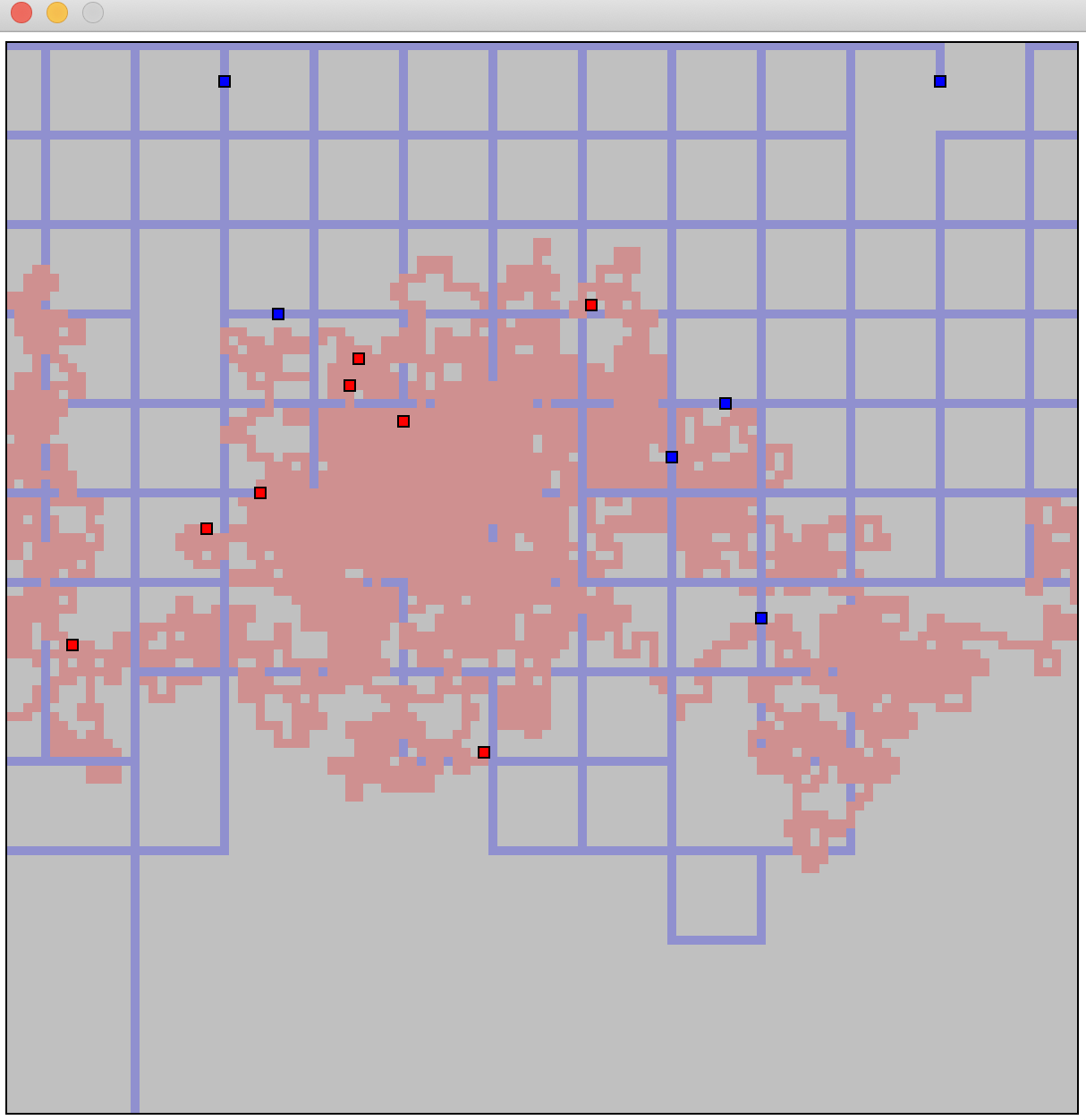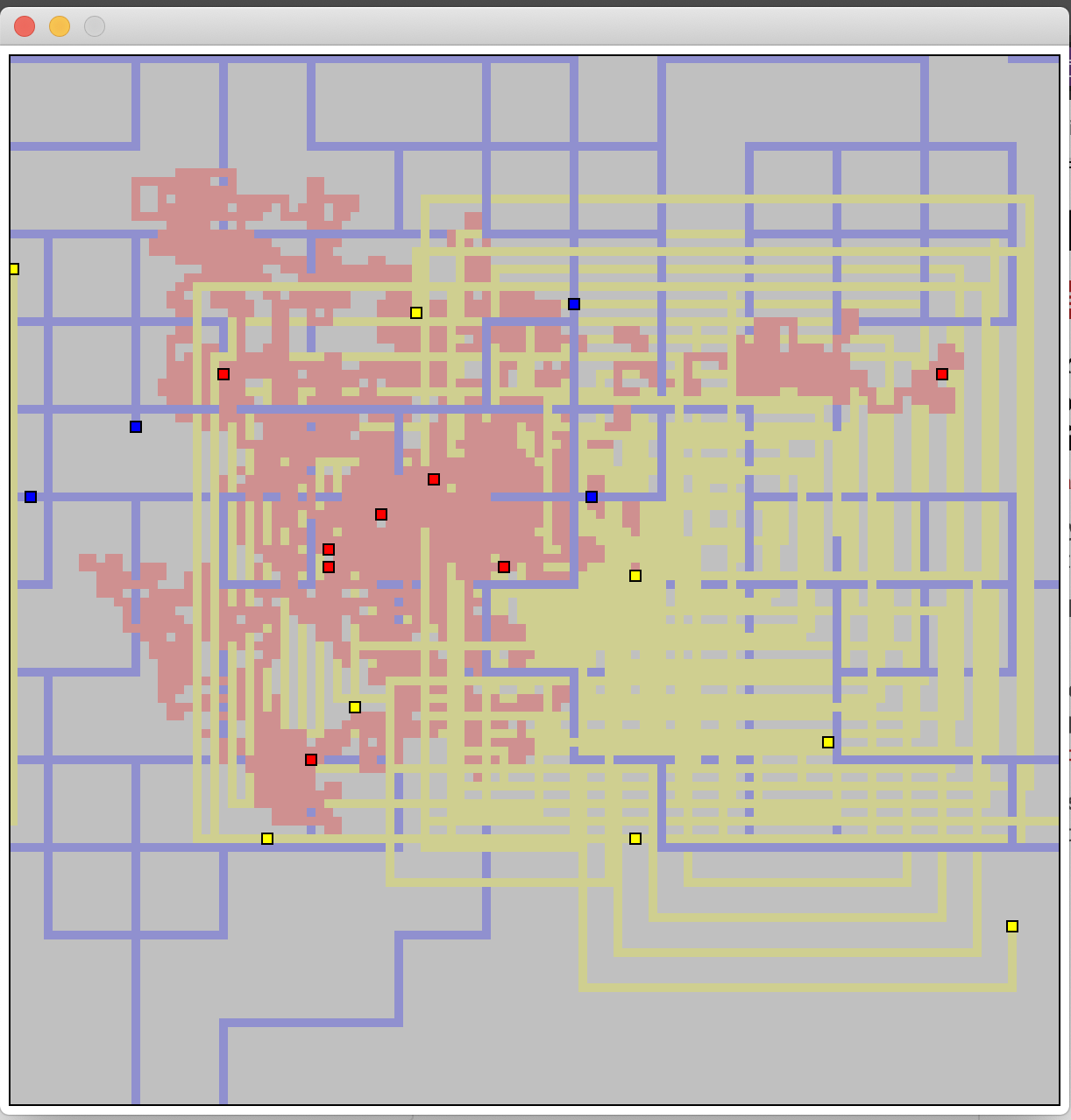Lab 2: I’m a dot thing living in a grid world
View the video for this lab on youtube.
Setup
Download the DotChaser.java file.
Download the Plotter.jar file.
Download the Lab2_Tester.java file.
Github setup
Use git, as discussed in Lab 0, to create a repo called gitusername-lab2, add these two files to it, and commit and push the changes to github. The timestamp of your invitation of the grader as a collaborator must be from this lab session.
Running your program
Run your lab on the command line by executing the following pipeline
java DotChaser | java -jar Plotter.jar
The program Plotter.jar is provided for you.
Part 1: Rewriting the code using OOP
Take a look at the DotChaser program. You can compile and run it as is:
javac DotChaser.java
java DotChaser
You’ll see some interesting (but boring) output.
55 50 b
45 50 r
done
56 50 b
45 51 r
done
57 50 b
46 51 r
done
58 50 b
.
.
.
Each line represents the location and color of a “Thing” dot in each round. The end of a round is indicated by “done”
55 50 b <- round i, blue dot at row 55, column 50
45 50 r <- round i, red dot at row 45, column 50
done <- end round
56 50 b <- round i+1, blue dot at row 56, column 50
45 51 r <- round i+1, red dot at row 45, column 51
done <- end round
As noted, a list of coordinates is pretty boring, so we also provided you a Plotter program that reads coordinates from stdin and plots them for a nice little visual of moving dots. Try it out yourself:
java DotChaser | java -jar Plotter.jar
Troubleshooting
If the GUI window does not load onn Windows, try to either run java through the command line “as administrator”, and/or install WSL and run it from a WSL shell. Post to Ed right away if you get stuck – you may not be able to figure this part out on your own.
The output of DotChaser is piped into Plotter, which plots each of the dots at the row,col coordinates and color given. The “done” at the end of a group of lines tells us that we are done with the “round”, so now the updated display should be shown, and what follows will be values for the next “round”. What you get is a really pretty animation like below.

So what do you have to do? Well, the program DotChaser is written entirely as a Procedural Program. You will re-write it as an Object-Oriented Program, and once done, you will extend its functionality a bit as well.
Note that the plotter can plot more than just red and blue. Here are your color choices as you make your things: r (red), b (blue), g (green), y (yellow), o (orange), p (pink), m (magenta), k (black).
Part 1: Create a UML diagram for your Things
Use Violet UML (or another tool, or paper) to generate a UML diagram for your many Thing types after reading the explanations below.
Create a UML diagram. Include it in your repo, named ‘UML.png’ and link it into your README.
Part 2: Rewrite DotChaser functionality into several classes using good OOP
Rewrite DotChaser as an object-oriented program. You will (presumably) be creating other .java files as well. The output of DotChaser should not change, but the design must follow all the good object-oriented design principles we have discussed. In particular, you must use encapsulation, information hiding, inheritance, and polymorphism. Maximize code reuse; keep implementation and interface as separate as possible. Your inheritance should follow the picture on the right.
You must do these things:
- Refactor the code only: do not change variable names or method names; reuse the existing fields and methods.
- Remove static methods: only
main()should be static in all of your classes. - Polymorphism: You should have
TypeAandTypeBclasses; observe how they differ. Your parent classThingmost likely will not need a single if statement. If you find you need one/more, make sure there isn’t a way to utilize polymorphism instead. If you still find the need for if statements, ask your instructor if they are appropriate. Related to this, your child classes should have at least one method which demonstrates polymorphism. This should naturally come from your design, but we make note of it here as a requirement to give you that extra nudge. - Use a linked list: Remove
Nodefrommain()and write aListorQueueclass calledThingList. You’ll have to write this. Yourmain()should not haveNodevariables anymore, but instead aThingListvariable with nice calls such aslist.add(thing). You need to write this code yourself; do not use ChatGPT (for example) to generate this linked list. - README.md: In the README file and write a paragraph (or two) that explains how your redesign makes use of encapsulation, information hiding, inheritance and polymorphism.
Be sure to add all your new Java files to the repo for submission.
Part 3: Add a new Thing
The original DotChaser had two types of Things: typeA, which randomly choses left, right or straight at every round; and typeB, which randomly chooses left, right or straight every 10th round. Now that you have a nice object-oriented version, create a third type of Thing called TypeC. What exactly it does is up to you, but it needs to use some diagonal motion (i.e. left-right-left-right-… sequences, or draws a circle, triangle, or other shape). The principal thing to keep in mind is how OOP makes this easier and cleaner.
Create a third ThingC type that must have.
- Ensure that the orignal
DotChaserstill works the same as before, even after you’ve added your new type ofThingC. That is, the red and blue dots act normally. - The new type of
ThingCmust move in a new way different thantypeAortypeB. - In your
README.mdindicate the name of the new type and the Java file used to program it. Be sure to add that file to your repo for submission :) - Add a paragraph to the
README.mdfile that explains how your new OOP design makes adding new types ofThingCeasy. - Add a final paragraph to the
README.mdthat explains exactly where in your program there is a polymorphic function call, and how that plays an essential role in the program functioning properly.
Be sure to add all your new Java files to the repo for submission.
Here’s an example of a solution with an extra yellow thing doing spirals:

Grading rubric and submission
Junit testing
To run your unit tests – remember, you need to have the junit jar file in the same directory – compile and run your code with the following commands on the terminal (depending on your OS):
Windows
javac -classpath ".;junit-platform-console-standalone-1.7.0-M1.jar" *.java
java -classpath ".;junit-platform-console-standalone-1.7.0-M1.jar" org.junit.runner.JUnitCore Lab2_Tester
Mac/Linux
javac -classpath ".:junit-platform-console-standalone-1.7.0-M1.jar" *.java
java -classpath ".:junit-platform-console-standalone-1.7.0-M1.jar" org.junit.runner.JUnitCore Lab2_Tester
Use git, as discussed in lab zero, to submit your work in a repo called gitusername-lab2. You will be graded on the following:
| Item | Points |
the name of the repo for this lab matches the pattern gitusername-lab2 |
3 |
| the grader has been added as a collaborator to the repo | 4 |
| the repo has been made private | 3 |
[unit test] TypeA and TypeB are child classes of Thing |
5 |
[unit test] Thing does not use if-statements nor the instanceof operator |
5 |
[unit test] no static methods besides main in any of your classes |
5 |
[unit test] the Thing class is responsible for movement, utilizing good OOP |
5 |
[unit test] the Thing class contains the appropriate fields, utilizing good OOP |
5 |
[unit test] the Thing class uses abstraction appropriately in all places, utilizing good OOP |
5 |
[unit test] the TypeA and TypeB contain the minimum number of fields necessary (declare each on a new line), utilizing good OOP |
5 |
[unit test]TypeA and TypeB contain the minimum number of methods necessary, utilizing good OOP |
5 |
[unit test] the ThingList class contains the Node class as an inner class, utilizing good OOP |
5 |
[unit test] the ThingList class has methods to addAll, moveAll, and printAll Things inside the list/queue |
5 |
TypeA, TypeB, and TypeC classes turn appropriately upon visual inspection, utilizing good OOP |
20 |
| a README file as specified above is included | 10 |
| a UML diagram matching the code implementation as been included, that lists all classes and their methods and fields | 10 |
| TOTAL | 100 |